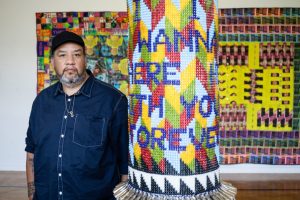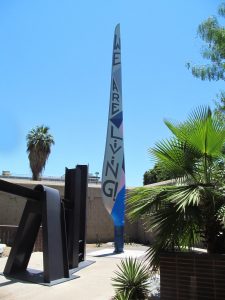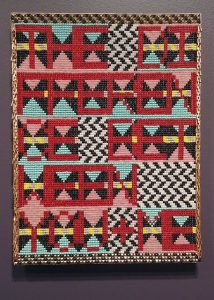Portfolio on Jeffrey Gibson
Jeffrey Gibson is an artist within the United States who is of Choctaw-Cherokee heritage. His contemporary art style combines both modern objects from American culture and blends these with traditional Indigenous techniques and styles. This unique and striking blend encourages viewers to consider and respect the diversity of culture that surrounds us. Gibson’s work also serves as a reminder that although many Indigenous voices have been silenced, Indigenous people are still living, current, and modern. Common Themes
The common themes that I found when viewing Jeffrey Gibson’s artwork were identity, community, inclusivity, and diversity. These themes carry on through all of his art pieces and installations. In many, his use of modern objects that are easily recognizable within U.S. culture, paired with Indigenous art styles help convey the diversity that exists in the county. Upon closer inspection some art pieces contain a quote or message for viewers to read. These messages encourage the viewers to think of the U.S. history and the struggles that many Indigenous people have faced. Having these messages shown on modern objects help show that these stories are still current and also show that these cultures are part of modern American culture.
Analysis

This photo is of an art piece from a very popular art installation by Jeffrey Gibson. In this exhibit he has decorated punching bags which are typically seen as objects that represent both masculinity and anger. Gibson has covered it in colorful beads, fringe, and messages which signify his anger and frustration with accepting cultural identity in society. The contrast of taking what is normally a neutral, bland punching bag and covering it in vibrant colors can be a representation of transposing gender identities and roles. Gibson spoke of how he was working through issues in his life his trainer encouraged him to envision the punching bag as whatever was causing him to feel how he felt. So, this exhibit gives insight as to how Gibson was fighting with his sense of identity and this struggle translates to many others as they live in the United States and are surrounded by the same gender and cultural norms.

This windmill blade was hand-painted by Jeffrey Gibson as part of the art project “Desert X”. Desert X is a project that is showcased on land that once belonged to the Cahuilla people and is largely representative of Indigenous voices and artists. Gibson chose a wind turbine blade for the vast size and impact it would have on viewers placed standing upright against the desert landscape. He painted the blade with the words “We are living” it serves as a vibrant and large reminder that Indigenous people still exist. There were others with “I am alive” “You are alive” and “They are alive” painted along the blades, encouraging unity and the reminder that despite differences, we all have things in common, at the end of the day we are all human. This message speaks even stronger when you realize that the land it is placed on is land that first belonged to the Cahuilla people and that nearly 80% of their population died due to the smallpox epidemic caused by Western colonizers in the 1860s.

This photo shows a piece of art that upon closer inspection contains a message within the geographic designs. It reads “The Difference Between You + Me”, this piece of art is beautiful, and some may enjoy it without ever seeing the words. To me, this means that despite our differences we can come together and create something beautiful, encouraging community with diversity and acceptance.
Application
This type of art is incredibly important in society. Not only does it speak out against Colonization, but it works to decolonize American art by giving a voice to Indigenous people and letting Indigenous art be showcased by a modern-day Indigenous artist. Much Indigenous art shown in museums has often been stolen from past communities and is not accurate at portraying current Indigenous views and styles. It helps viewers find a sense of identity and self while recognizing that Native American culture still exists and is alive in the United States. It showcases that not all Indigenous art will look the same as people within the same culture are all still different and unique. Gibson’s art takes viewers on a journey by addressing the past and then using a blend of modern objects in his work to showcase Indigenous style in the present. His art shows how living in the United States affects Indigenous people and showcases cultural hybridity, it also highlights how cultural hybridity can affect people and their sense of identity.
Sources:
Desert X, https://desertx.org/.
Drexelius, Alexandra. “Jeffrey Gibson.” Toward Common Cause, https://towardcommoncause.org/artists/jeffrey-gibson/.
Schedeen, Kaila. “Call and Response: A Conversation with Jeffrey Gibson.” Sightlines, 16 Aug. 2019, https://sightlinesmag.org/jeffrey-gibson-blanton-exhibition-interview.
“The Cahuilla People.” Augustine Band of Cahuilla Indians, https://augustinetribe-nsn.gov/cahuilla-people/.

